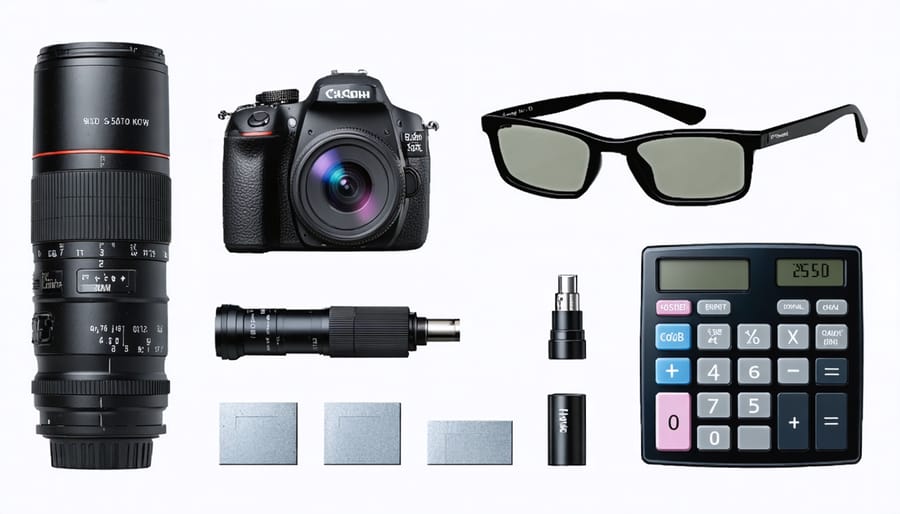
Managing wealth as a professional photographer requires different strategies than traditional nine-to-five employees. While capturing stunning images drives your passion, protecting and growing your irregular income demands specialized financial expertise. Many successful photographers reach a tipping point where their earnings potential outgrows their financial knowledge – that’s when a wealth management professional becomes invaluable.
These advisors understand the unique challenges of creative professionals: seasonal income fluctuations, equipment investments, complex tax situations, and retirement planning without employer benefits. They can help transform sporadic photography earnings into sustained financial security through tailored investment strategies, tax optimization, and business succession planning.
Think of a wealth manager as your financial art director – someone who sees the big picture while managing crucial details. They’ll help balance immediate business needs (like new gear purchases) with long-term goals (like retirement or studio expansion), all while navigating the complexities of self-employment taxes and business structures.
But not all financial advisors understand the creative industry’s unique dynamics. Just as you wouldn’t trust your flagship wedding shoot to an amateur, your financial future deserves an advisor who speaks both the languages of finance and creative entrepreneurship.
The Photographer’s Financial Landscape
Irregular Income Patterns
Professional photographers often face unique income patterns that can make financial planning particularly challenging. Unlike traditional careers with steady paychecks, photography income typically follows seasonal trends and project-based cycles. Wedding photographers, for instance, might earn the bulk of their income during peak wedding seasons in summer and fall, while experiencing slower periods during winter months.
Commercial photographers frequently deal with large but irregular project payments, sometimes waiting weeks or months between major assignments. This feast-or-famine cycle requires careful cash flow management and strategic planning to ensure financial stability throughout the year.
These irregular income patterns can impact everything from tax planning to investment strategies. Many photographers find themselves struggling to balance reinvestment in their business with personal savings goals during high-income periods, while needing to carefully manage expenses during leaner months.
Understanding these fluctuations is crucial for effective wealth management. Smart financial planning includes creating emergency funds sized appropriately for longer income gaps, establishing tax reserve accounts, and developing investment strategies that account for irregular contribution patterns.
Equipment Investment Cycles
Managing equipment investments is a critical aspect of financial planning for photographers, particularly when it comes to high-value cameras, lenses, and studio equipment. Professional photographers must carefully balance the need to stay competitive with technology investments in photography against their cash flow and depreciation considerations.
A strategic approach to equipment cycles typically involves planning purchases around tax years, peak booking seasons, and the natural depreciation of gear. Many successful photographers work with wealth management professionals to create a structured replacement schedule that maximizes tax benefits while maintaining equipment quality. This might mean spacing out major purchases rather than upgrading everything at once, or timing acquisitions to coincide with strong revenue periods.
Understanding depreciation schedules is particularly important, as professional camera equipment can lose value quickly. A good wealth manager can help photographers leverage Section 179 deductions and other tax benefits while maintaining adequate insurance coverage for their gear. They can also advise on whether leasing options might be more advantageous than outright purchases for certain pieces of equipment.


What a Wealth Management Professional Brings to the Table
Business Structure Optimization
As a photographer, choosing the right business structure is crucial for both protecting your assets and optimizing your tax situation. While many photographers start as sole proprietors, this structure may not offer the best protection or tax advantages as you grow your photography business.
Limited Liability Companies (LLCs) offer an excellent balance of asset protection and tax flexibility. They shield your personal assets from business liabilities while allowing you to choose how you’re taxed – either as a sole proprietorship, partnership, or corporation. This flexibility can be particularly valuable during different phases of your career.
S-Corporations can provide significant tax advantages for photographers earning substantial income. By allowing you to split your income between salary and distributions, you may reduce self-employment taxes. However, this structure requires more rigorous compliance and paperwork.
The key is working with a wealth management professional who understands both photography business models and tax law. They can help you:
– Structure your business to minimize tax liability
– Plan for quarterly estimated tax payments
– Maximize deductions for equipment and business expenses
– Create strategies for retirement savings
– Navigate state-specific tax implications
Remember that your business structure should evolve with your success. What works when you’re shooting weddings on weekends might not be optimal when you’re running a full-service studio with employees. Regular reviews with your advisor ensure your structure continues to serve your financial goals effectively.
Investment Strategy for Creatives
Creative professionals, especially photographers, face unique challenges when it comes to investment planning due to irregular income patterns. The key is developing a strategy that provides both stability and flexibility while accounting for the ebbs and flows of creative work.
Start by establishing a robust emergency fund that covers 6-12 months of expenses, which is particularly crucial for freelance photographers. This buffer helps manage slow periods while you work to attract more photography clients.
Consider a “bucket strategy” approach to investments, dividing your portfolio into three segments: short-term needs (1-2 years), medium-term goals (3-5 years), and long-term growth (5+ years). This structure allows you to maintain liquidity while still pursuing growth opportunities.
For variable income streams, dollar-cost averaging can be adapted to your cash flow. Instead of investing fixed amounts monthly, consider percentage-based investing during high-income months. For example, allocate 30% of earnings above your baseline expenses to investments during successful wedding seasons or commercial projects.
Look into specialized investment vehicles like SEP IRAs or Solo 401(k)s, which offer tax advantages specifically designed for self-employed creatives. These options typically allow for higher contribution limits compared to traditional retirement accounts, helping you maximize savings during profitable periods.
Remember to regularly review and adjust your investment strategy as your creative business evolves and market conditions change. Working with an advisor who understands the creative industry can help fine-tune this approach to your specific situation.
When to Hire a Wealth Manager
Recognizing when to hire a wealth manager is crucial for protecting and growing your financial assets. Several key indicators suggest it’s time to seek professional financial guidance, particularly for photographers managing both personal and business finances.
One clear signal is when your income reaches a significant threshold, typically around $250,000 annually or when your investable assets exceed $500,000. At this point, the complexity of tax planning, investment strategies, and retirement considerations often requires expert oversight.
Major life changes also warrant professional financial guidance. This includes expanding your photography business, purchasing expensive equipment, opening a studio, or planning for succession. These transitions often involve complex financial decisions that can benefit from professional expertise.
If you’re struggling to balance multiple financial priorities – such as business expansion, retirement planning, and personal investments – it’s probably time to consult a wealth manager. This is especially relevant for photographers who may have irregular income streams or need to manage seasonal business fluctuations.
Time constraints can be another compelling reason. When managing your finances starts taking valuable time away from your creative work and client relationships, a wealth manager can help streamline your financial operations and ensure nothing falls through the cracks.
Additionally, consider seeking professional help if you’re facing complicated tax situations, such as operating in multiple states or managing international clients. A wealth manager can help navigate these complexities while ensuring compliance and maximizing tax efficiency.
Finally, if you find yourself uncertain about investment decisions or feeling overwhelmed by financial planning, it’s worth consulting a professional. A qualified wealth manager can provide objective guidance, helping you make informed decisions about your financial future while considering both your personal and professional goals.
Remember, the right time to hire a wealth manager isn’t solely determined by your net worth – it’s when the complexity of your financial situation demands expertise beyond your comfort zone or available time.

Choosing the Right Financial Partner
Essential Questions to Ask
When interviewing potential wealth management professionals, ask these crucial questions to ensure they’re the right fit for your photography business:
“What experience do you have working with creative professionals or photographers specifically?” Look for advisors who understand the unique income patterns and challenges of the photography industry.
“How are you compensated?” Be wary of advisors who hesitate to explain their fee structure clearly. Ask about commissions, flat fees, or percentage-based charges.
“What’s your investment philosophy?” Their approach should align with your risk tolerance and business goals. Red flags include pushing aggressive investments without explaining the risks.
“How often will we communicate?” Regular check-ins are essential, especially during busy shooting seasons. Be cautious of advisors who seem dismissive of your need for flexibility.
“What certifications do you hold?” Look for credentials like CFP (Certified Financial Planner) or CFA (Chartered Financial Analyst). Watch out for those who can’t verify their qualifications.
“Can you provide references from other creative professionals?” Quality advisors should happily connect you with satisfied clients in similar fields.
Remember, if an advisor seems more interested in selling products than understanding your photography business’s unique needs, that’s a major red flag.
Managing your wealth as a photography professional requires careful consideration and strategic planning. Throughout this article, we’ve explored how wealth management professionals can help photographers navigate their unique financial challenges, from irregular income streams to business expansion and retirement planning.
Remember that the right financial advisor should understand both personal finance and the specific needs of creative professionals. They can help you balance equipment investments, studio expenses, and long-term wealth building while maintaining financial security for you and your business.
As you consider taking the next step, start by assessing your current financial situation and goals. Are you looking to expand your studio, transition to a different photography niche, or plan for retirement? These objectives will help guide your search for the right wealth management professional.
Begin by researching potential advisors, checking their credentials, and scheduling initial consultations. Look for professionals who have experience working with photographers or other creative entrepreneurs. Don’t hesitate to ask for references and examples of how they’ve helped similar clients achieve their financial goals.
The journey to financial success in photography doesn’t have to be a solo endeavor. With the right wealth management partner, you can focus more on your craft while ensuring your financial future remains secure. Take action today by reaching out to qualified professionals who can help you build and protect your wealth while growing your photography business.























